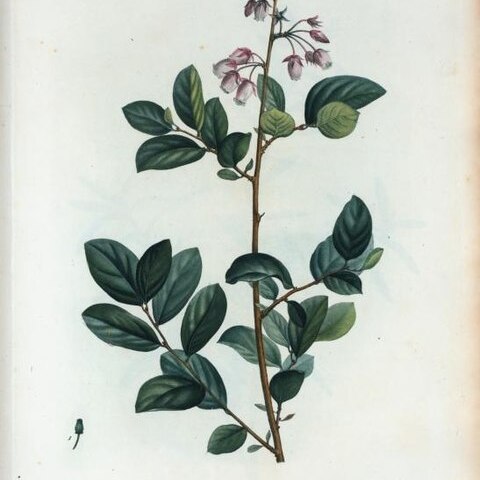Shrubs, to 1.5 m. Stems erect, terete to slightly angled. Leaves deciduous; blade narrowly to widely elliptic, ovate, or obovate, (2.5-)3-8(-10.5) × 1-4(-5) cm, membranous, base narrowly cuneate to rounded, margins entire, plane to slightly revolute, apex acute to rounded-mucronate or slightly acuminate, surfaces scattered, multicellular, glandular short-headed-hairy, not lepidote, otherwise glabrous or hairy on major veins, intramarginal vein absent. Inflorescences fascicles, developing from buds along distal portion of stems of previous year; bracts 1 per flower, linear-lanceolate, to 4.5 mm. Pedicels glandular-hairy, not lepidote. Flowers: calyx lobes 3-9.5 × 1-4 mm, glandular-hairy, not lepidote; corolla usually white, rarely pink, cylindric (base not swollen), 7-14 × 4.5-9 mm; filaments 4-7 mm, long-hairy, especially near base, with 2 ± well-developed spurs. Capsules ovoid, 4-6.5 × 3-6 mm, apex strongly constricted, short-headed-hairy, otherwise glabrous or hairy; sutures usually remaining attached to adjacent valve; placentae central to nearly basal. 2n = 24.
More
Deciduous shrubs to 2 m; lvs elliptic to oblong, 3–6 cm, commonly obtuse, entire, hairy on the veins beneath; petioles 2–4 mm; umbelliform clusters not subtended by lvs; pedicels 1–2 cm, bracteolate at the very base; sep narrowly oblong, 4–10 mm, deciduous in winter; cor 9–13 mm; stamens with a pair of ± well developed spurs near the junction of the anther and filament; fr truncate-ovoid, 5 mm thick and usually longer; 2n=24. Moist, sandy soil, especially near the coast; R.I. to e. Pa., Tenn., s. Mo., Tex., and Fla. (Neopieris m.)

